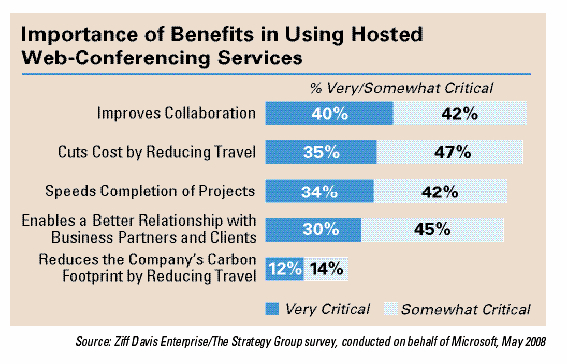Re:Tooling -- Web Conferencing: Calling Your Conference to Order
The days when your entire team had to physically gather in one room, at a costly offsite center, or around a single desk to shuffle papers and sift through pie charts are largely over. Thanks to geographically dispersed organizations and the increased cost of business travel, Web conferencing solutions are gaining popularity for meetings, training, and presentations.
"People are definitely more interested [in Web conferencing]," explains Jeffrey Mann, research vice president and agenda manager for collaboration at industry-analysis firm Gartner. Mann explains there are three main reasons why companies consider Web conferencing: money, environmental impact, and travel hassle.
Sanjeev Aggarwal, vice president for small-to-midsize business (SMB) infrastructure solutions at analyst firm AMI-Partners, cites many of the same reasons for Web conferencing's impact. "Driven by the global economic crisis, high travel costs, increases in gas prices, and natural disasters, the relevance of conferencing solutions increases enormously," he said in a statement. "[They] help reduce costs, provide clearly identifiable [return on investment], and drive business growth."
Hyoun Park, research editor of the technology markets group at Aberdeen Group, says companies can quantify the potential savings simply by looking at the amount of travel that would otherwise be required to bring together dispersed employees.
According to Gartner's Mann, companies wishing to connect two or three people in a limited manner have some free options for Web conferencing. That said, he explains that if you're looking at a standard application on a per-moderator or per-organizer model, companies can expect to lay out anywhere between $20 and $40 per month. A really big meeting of perhaps 10,000, Mann says, can "get up into a couple of thousand dollars."
Thanks to the low- and no-cost offerings, companies have invested serious money in Web conferencing solutions, to the tune of $935 million in 2006, according to Gartner. Alongside other collaborative features such as calendaring, email, instant messaging, and presence, this capability will be available to 75 percent of corporate users by 2010, thanks to what Gartner predicts will be a 19.5 percent compound annual growth rate (CAGR). SMBs will also be spending more on Web conferencing—$693 million in 2012, according to AMI, a CAGR of 10.2 percent.
Some vendors may benefit—Adobe, IBM, Microsoft, and Cisco Systems' WebEx—but Mann doesn't see other competitors moving up to the leader position any time soon. "WebEx is pretty far-and-away above the rest in terms of market share," he says. "It's a pretty vibrant market, but it's also a fairly mature one."
There are some moves, though, as more companies are turning away from the traditional hosted model. Gartner forecasts that, by the end of this year, roughly 40 percent of all Web conferences will be operated using on-premises deployments.
"This had been done primarily in a hosted model because of bandwidth requirements," Mann recalls. "Web conferencing was scary and exotic...better left to external suppliers. With increasing acceptance of [Voice over Internet Protocol] and bandwidth [becoming] more plentiful, it's not as scary as it was." One new concern, as more data streams across conferences, is data security.
Multimedia solutions such as Cisco's Telepresence—uniting audio, video, and Web to transform the look, feel, and sound of the experience—are also gaining traction. "Best-in-class companies are using video conferencing as a replacement," Park says. "People are using that visual channel as a way of bringing in additional interactivity to communication."
Mann also believes the market will adapt. "More options for integrated audio is one trend, and video is coming," he says. "All [the solutions] can offer the option if you plug in a webcam."
SIDEBAR: Questions to Consider When Web Conferencing
- What is the scale and volume of the Web conferencing demand?
- What types of meetings—training, support, ad hoc, motivational, collaborative—are you most interested in?
- Do most meetings happen inside the firewall, or beyond it?
- Whom do you meet with—colleagues or customers?
- Where are meeting participants coming from—on-campus or worldwide?
- Do the Web conferences have high exposure with senior executives or a large number of customers participating?
- What kinds of IT investments are you prepared to make?
Source: Gartner

Contact Assistant Editor Christopher Musico via email at cmusico@destinationCRM.com.
Every month, CRM magazine covers the customer relationship management industry and beyond. To subscribe, please visit http://www.destinationcrm.com/subscribe/.
Here's a quick link to more of this month's special coverage — The Recession Issue.
Related Articles
Dimdim Opens Up Web Conferencing to Open Source
10 Apr 2009
Pundits say this latest version aims squarely at traditional players including Cisco Systems' WebEx and Citrix's GoToMeeting.
Make Marketing Your Megaphone!
01 Feb 2009
When budgets are tight, it's your job to calm skittish customers and capture the few viable prospects. You can't be everywhere at once, so be where you're most effective.
Buyer's Guide Companies Mentioned